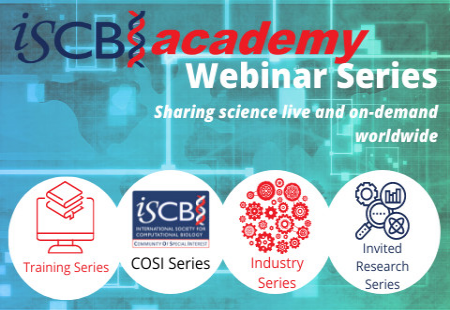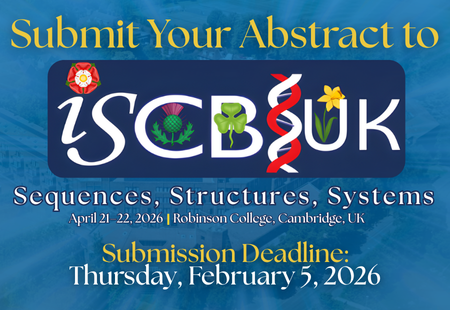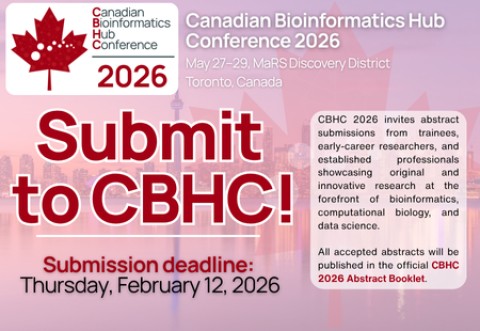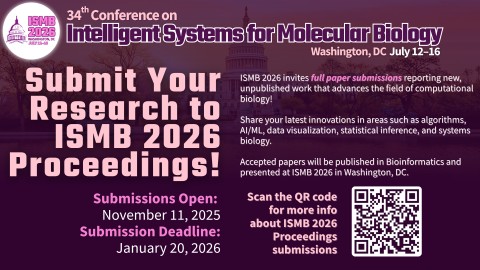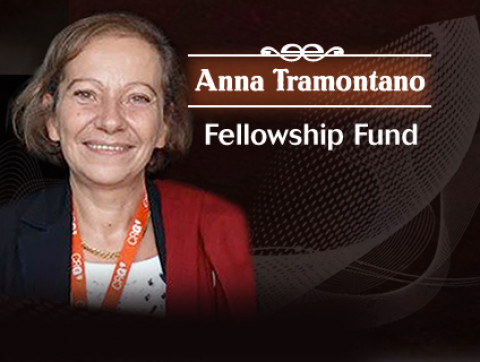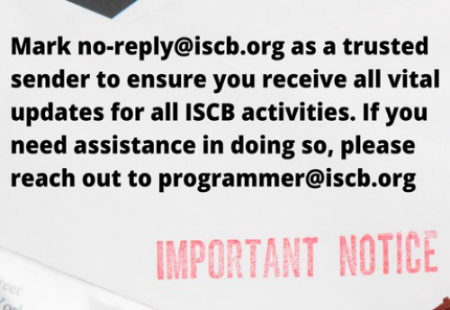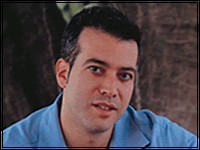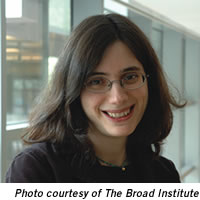|
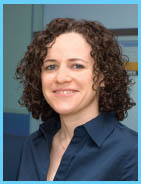 Picture: 2011 Overton Prize Winner, Picture: 2011 Overton Prize Winner,
Olga Troyanskaya
Photo courtesy of Princeton University, Office of Communications.
|
2011 Overton Prize: Olga Troyanskaya
In the spring of 1997, Olga Troyanskaya was working on a degree in computer science and biology at the University of Richmond, Virginia, when she contacted Steven Salzberg, then at Johns Hopkins University, about a summer internship in his lab devoted to computational biology. "He took a chance on me—a random student from another school—and was tremendously inspirational," she says. She spent the following two summers working in Steven Salzberg's laboratory, first at Johns Hopkins and then at The Institute for Genomic Research.
And so began the career of one of the most promising young researchers in bioinformatics, and a deserving winner of this year's Overton Prize. "She is one of these forces of nature, full of energy,” says Alfonso Valencia, chair of the ISCB awards committee.
Troyanskaya herself talks with infectious enthusiasm about her work. "I've always been fascinated by the problems of biology,” she says. “I was just better at computer science and math than the wet lab research. And it seemed to me that there had to be a lot you could contribute with computer science that you couldn't do with experimental techniques alone.”
From the University of Richmond, Troyanskaya moved to Stanford University to complete a PhD in biomedical informatics, under the supervision of Russ Altman, a bioinformatician, and David Botstein, a geneticist. "I wanted a setup that was close to real biological problems, and I got exactly that. I learned a great deal from both of them," she says.
In 2003, she moved to Princeton University as an assistant professor in the Department of Computer Science and the Lewis-Sigler Institute for Integrative Genomics. "I am fortunate that the computer science department appreciates the impact of computing in biology, and that I have many wonderful colleagues at both the department and in the Institute. I found several amazing collaborators, and this allowed me to begin a number of interesting projects."
One of the key problems she focuses on is making better use of the vast but unwieldy biological datasets in databases around the world. “So instead of focusing on one study, we can take the entirety of published data. That allows you to ask very specific questions in a data-driven way and to develop novel biological hypotheses,” she says.
An important goal is to predict the function of genes or proteins. There have been many experimental approaches to determine what genes do and how they are controlled inside the cell. But this work tends to produce datasets that are large and noisy. Troyanskaya's approach is to develop new ways for extracting useful information from these datasets using techniques from computer science such as machine learning and data mining.
"Computation by itself is often not enough to discover new biology but it can direct experimental work," she says. And she has set up a wet lab to help test and validate the hypotheses that the computer science helps generate. In 2009, for example, she used this approach to identify 109 new proteins involved in mitochondrial biogenesis in yeast.
This combined approach is one of the things that sets Troyanskaya apart, says Valencia. "She is one of the first to have come from the computational side and then moved into the experimental area to combine both,” he says.
Understanding the function of individual genes is only a small part of a much bigger story. Many genes and proteins play multiple roles within a cell as parts of various networks of biological processes. Mapping out these networks and understanding how they work and interact with each other is yet another strand of her research. "She has made important contributions to systems biology," says Valencia.
The process of evaluating and validating computational predictions is an area requiring a broad collaboration to develop standards and methods that can be used to achieve a consensus about the results. To this end, Troyanskaya is collaborating with the curators of model organism databases and members of the Gene Ontology Consortium.
Another problem that many researchers face is handling the data avalanches currently being generated. So Troyanskaya, in collaboration with Princeton colleagues Kai Li and Moses Charikar, is looking at ways to better search and visualise these huge datasets, something that is challenging because of high noise levels and the enormous volume of the data. "We are developing better ways to do this," she says.
The awards committee was also impressed by Troyanskaya's service for the community. She is involved in the Society's two official journals, PLoS Computational Biology and Bioinformatics. And she is involved in conferences: organizing, chairing tracks and program committees. "That is something that is very much appreciated," says Valencia. "We are lucky to have her."
And there is surely more to come. Troyanskaya points to numerous questions that are driving her research forward. She wants to know, for example, how we can predict which genes are involved in kidney disease, to understand their function and their clinical role on a molecular level. She works on these questions in close collaboration with experimental researchers, such as Matthias Kretzler and his group from the University of Michigan, Ann Arbor. And she is passionate about finding ways to ask questions in a data-driven way, not just in a knowledge-driven way that relies on what we already know about biology. "These are the questions that I'm really interested in," she says. "And we really haven't yet harnessed the full potential of our data collections."
--
This article is excerpted from the June 2011 issue of PLoS Computational Biology. To link to the full journal article please visit www.ploscompbiol.org/article/info%3Adoi%2F10.1371%2Fjournal.pcbi.1002081
>> Return to List of Overton Prize Recipients
Congratulations to 2012 ISCB Overton Prize Winner
|
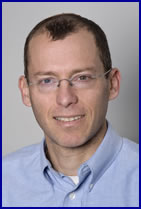
|
Picture: 2012 Overton
Prize Winner,
Ziv Bar-Joseph |
Ziv Bar-Joseph loves to run. He rises early and hits the streets and trails around Pittsburgh where he lives, often in training for a long-distance race. This dedication has paid off. He has the enviable distinction of having run a sub-three hour marathon, a feat achieved by few amateurs. "Running is very important to me," he says.
But it is not just in his running that Bar-Joseph shows a willingness to go the distance. As a computer scientist and computational biologist at Carnegie Mellon University in Pittsburgh, Bar-Joseph shows a similar dedication as head of the Systems Biology Group at the School of Computer Science. "We have all been impressed by the novelty of the approaches he has developed," says Alfonso Valencia, chair of the ISCB Awards Committee.
Bar-Joseph gained a PhD in computer science from the Massachusetts Institute of Technology between 1999 and 2003. That time turned out to be hugely significant, not least because computational biology was undergoing a revolution. "For the first time, we were getting sequences for large species. First, the fly, then humans. It was very inspiring," he says.
Initially, Bar-Joseph knew little about computational biology but took a class to better understand the significance of these advances and the problems they posed. "It seemed to me that these types of problems were well-suited for the machine learning tools I had experience with," he says.
One of the key problems was how to compare sequences either within species or between them. Various researchers had developed methods to do this using a branch of computer science called combinatorics, which essentially counts the number of similar patterns.
But while this works well when comparing two sequences, it's not so good for comparing seven or eight sequences. It doesn't scale. Consequently, researchers began to experiment with probabilistic approaches that focus on the statistical properties of the patterns. In particular, computational biologists had significant successes with a statistical approach called a hidden Markov model. That attracted Bar-Joseph who had studied this model.
He also recognised that other earlier studies, attempting to reconstruct networks in cells, were significantly limited: the data was a snapshot of a complex dynamic system but they treated it as if it were static.
Clearly, biological systems change. "One thing I've been involved in is introducing dynamics into the algorithms so that they can cope with the way things change in time. That requires different tools," he says.
The approach has paid off when it comes to understanding regulatory networks and explaining how proteins control each other. For example, yeast has about 6,000 proteins. Of these, some 250 are control proteins and each of these, on average, controls 100 or so other proteins. However, each control protein is itself controlled by a handful of other proteins.
Understanding a system like this is a tricky business. The static data can tell you what proteins control other proteins, but that doesn't tell you when and under what conditions because that requires more experiments.
Other types of data are more temporal and can reveal how protein levels change over time. "The question we asked was whether we can use this temporal data to try and recover the underlying network dynamics," he says. "We came up with methods to integrate these datasets in order to reconstruct the set of events over time and these have since been used in various other systems too."
Bar-Joseph has learnt to work closely with biologists who test the results. "If the algorithm predicts that 'a' controls 'b', for example, you can do the experiment to test whether that's true." That's important because the patterns that the algorithms reveal must be biologically relevant.
To better understand the challenges that experimentalists face, Bar-Joseph spent a sabbatical working in a wet lab doing exactly this kind of work. That taught him some valuable lessons. For example, wet lab work is not just a question of validating the model. "The results from the lab feed back into the model and enhance it. It's a two-way street," he says. Others have been impressed with Bar-Joseph's approach to experimental work. "Ziv is an example of somebody coming from the theoretical side of things and completely embracing the experimental approach," says Burkhard Rost, president of the ISCB. "It's stunning how he is able to handle such a diverse set of technical methods."
This process of feedback from biology to computer science has become an important theme in Bar-Joseph's work. One of his recent successes is in explaining the way fruit flies develop bristles on their foreheads. These bristles are like aircraft sensors, measuring temperature, wind speed, and so on. To work well, they need to be spaced in a very precise way.
The bristles grow from cells but clearly only a small subset of cells. The cells do not know how many neighbours they have or the local density of bristles nearby. So what determines which cells grow into bristles and the spacing between them?
Bar-Joseph quickly realised that this was similar to a problem that computer scientists have wrestled with for 30 years. This is the problem of determining the subset of computers in a network that control all the others. When each computer in the network is connected to one computer in this subset (but no two in the subset are connected to each other), this subset is called maximally independent.
Finding maximally independent sets is hard, particularly in large distributed networks. Computer scientists do it by assuming that every computer knows who all its neighbours are.
Bar-Joseph realised that the fruit fly cells that eventually become bristles form a maximally independent set---they are connected to all other cells but not to each other. However, they do not know who their neighbours are and so must solve this problem in a different way. His breakthrough was to work out how they did it and develop an algorithm that does the same thing while assuming no knowledge of the neighbours. "It takes a bit longer but that's the trade-off," he says.
This may have important applications for wireless sensor networks that researchers are using to monitor everything from ocean conditions to volcanic eruptions. "We only published at the beginning of 2011 so we don't know if it will penetrate the commercial world," he says.
Valencia is also impressed by Bar-Joseph's broader contribution to the computational biology community. "He is a member of the editorial board for the journal Bionformatics, so clearly his contributions go beyond this theoretical and experimental work," says Valencia. "That's very good for a young scientist."
The future holds many promising problems for Bar-Joseph too. He is particularly interested in studying how pathogens interact with cells, how the proteins from flu viruses interact with cell proteins, for example. "If we can reconstruct the networks of interactions then we might be able to determine intervention points that will guide us to therapeutics," he says.
He also wants to study the interaction networks in different species. Many of the genes in humans and mouse are similar, but drugs that work well in mouse often don't work in humans because the pathways, levels, and interactions are different. "We want to get more insight into this," he says.
That's clearly a long game. These are problems that will require dedication, talent, and endurance to solve. Exactly the kind of qualities you might find in a marathon runner.
-
This article is excerpted from the May 2012 issue of PLoS Computational Biology. To link to the full journal article please visit www.ploscompbiol.org/article/info%3Adoi%2F10.1371%2Fjournal.pcbi.1002535.
>> Return to List of Overton Prize Recipients
|
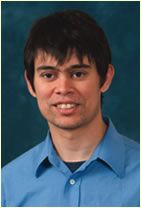
Picture: 2013 Overton
Prize Winner,
Goncalo Abecasis
|
Congratulations to 2013 ISCB Overton Prize Winner: Goncalo Abecasis
By Christiana N. Fogg, Freelance Science Writer, Kensington, MD
ISCB recognizes the achievements of an early or mid-career scientist annually with the Overton Prize. The Overton Prize honors the memory of G. Christian Overton, a prominent bioinformatics researcher and founding ISCB Board member who died suddenly in 2000. Winners of the Overton Prize are up-and-coming independent scientists honored for their significant contributions to computational biology through research, teaching, and service. ISCB is thrilled to recognize Dr. Goncalo Abecasis, Felix E. Moore Collegiate Professor of Biostatistics at the University of Michigan, as the 2013 winner of the Overton Prize.
Goncalo Abecasis was drawn to biology ever since he was a child. “From a young age, I have always been fascinated with understanding how life works,” said Abecasis. He fondly recalls spending Sundays at a bookstore with his parents and gradually collecting a small library of wildlife books.
But it was his experiences in a high school computer programming club that opened his eyes to an entirely different field. “Although I didn't know it at the time, a key skill that later contributed to my success in genetics was my interest in computer programming,” recalled Abecasis. “The club was meant to keep us busy and out of trouble, but they did encourage us to try programming and point us in the direction of very useful techniques, like object oriented programming and the like.”
Human genetics appealed to Abecasis as he pursued his undergraduate studies at the University of Leeds, and he landed a position in the lab of Dr. Mary Anne Shaw studying “how genetic variation in the interleukin-1 gene cluster, a set of immune genes where variation was easy to measure with then available techniques, was related to infection by Leishmania and other tropical parasites.” This experience proved invaluable for helping Abecasis to receive funding for his Ph.D. training in the lab of Dr. William Cookson at the University of Oxford.
Cookson’s lab was studying genes that contribute to asthma susceptibility at the Wellcome Trust Center for Human Genetics at Oxford. In the late 1990’s and early 2000’s, Abecasis described this Center as “a mecca for human geneticists at the time, with great support from the Wellcome Trust, and lots of smart people trying new ways to run genetic studies and looking to make rapid progress in many different traits.” Abecasis also recalled that, “as we pushed the limits of the sequencing and genotyping technologies of the time, we were soon generating datasets that were beyond the reach of existing analysis tools and methods.”
Abecasis saw that, “It was easy to realize that new analysis methods and computer software were needed -- and being in Oxford, working at the Wellcome Trust Center was just the right place to be.” With Cookson’s support, and under the comentorship of statistical geneticis Dr. Lon Cardon, Abecasis developed software to tackle the analysis of large genetic datasets. Abecasis remembered dealing with many software bugs along the way, but then, as now, he repeated the mantra to himself that “all software is buggy, and this is no exception!”
Abecasis was pursuing his Ph.D. at the same time as the race to sequence the first human genome was wrapping up. As the field of genomics was emerging, he realized that several of the methods he had developed could be used to look at how “individual genomes differed from this initial sequence and to understand how these differences contribute to the great diversity we see among people today.” The application of these methods to genome data also shifted his research focus away from “laboratory methods, technology and data generation,” and toward “issues related to study design and analysis.”
Abecasis’s unique knowledge and training in human genetics, biostatistics, and computational analysis landed him a faculty position in the Biostatistics Department at the University of Michigan. Abecasis recounted the support and mentorship of Dr. Michael Boehnke in the department. “Mike somehow convinced the Biostatistics Department at the University of Michigan to take a flutter on me, when I had just finished my Ph.D. and had much less formal training in statistics than most of my colleagues. He has always been generous with his time, and I probably can't count the times that I have interrupted him in his office, bounced some ideas off him, and came out energized and thinking about something new to try.”
Along with Boehnke, Abecasis acknowledged how fortunate he has been in the mentorship he received throughout his training, including the volunteers who taught him to code in his high school club. “As I knew them, I remember my mentors as demanding, generous with their time, unrelentingly positive and encouraging, and totally transparent. It is obviously a standard I'd like to meet, although I doubt I am there yet.”
Their example also motivates Abecasis to be a good mentor. “It is great to set a student free on an interesting open problem and have them solve it. You can do so much more with a few good trainees than you could ever accomplish on your own.”
Abecasis’s research, and the field of human population genetics in general, have been transformed by the advent of high-throughput genetics. “We now have very clear answers about the degree and structure of genetic variation in the world today, but have also gained a lot of detail on human population history -- including very ancient events, like admixture with Neanderthals,” said Abecasis.
Abecasis’s lab is now focused primarily on identifying genetic variants relevant to human disease. They look at linkage disequilibrium within human genomes in order to describe, “how groups of variants are shared among individuals.”
One of the observations that Abecasis’s group and others made several years ago that he recalled as being surprising was “that much of the genetic variation in any individual could be recovered very accurately by comparing each individual to a reference set of individuals and, more recently, we have used the process to make it relatively inexpensive to sequence large numbers of individuals. At our last count, >30,000 human genomes had been sequenced using our "low-coverage" linkage disequilibrium based approach.”
One of the highlights of Abecasis’s career was being invited to the White House in 2010. “I was thrilled. I remember I had very short notice (perhaps a couple of days) and had to rush and find something to wear, recalled Abecasis. Although it is cheesy, it is really amazing to live in a country that functions so much like a meritocracy. I didn't have to write a check, join a committee, vote - anything. I had a good idea about how to sequence a lot of genomes more rapidly, proposed it, and not only did I get funded to try it out (it worked, by the way), but my work was selected as one of the highlights for Vice President Biden’s speech on the important of technology development and biomedical research.”
Abecasis described the importance of collaborations to his research and is a strong proponent of sharing data and software tools. “So many great discoveries and advances come from bringing in insights, ideas and approaches from a different field,” said Abecasis.
But Abecasis also agreed that data sharing is not without challenges. “There are legitimate concerns about protecting the identity and privacy of research subjects and, once in a while, people do use data you share pre-publication to gain an advantage,” said Abecasis. “Still, there is no doubt we are moving in the right direction -- expectations for data sharing and collaboration are so much more open than when I started.”
Abecasis has felt fortunate to work with so many great collaborators. One of his most interesting collaborations has been his work with Drs. David Schlessinger, Francesco Cucca, and Serena Sanna and many others on the “SardiNIA project.” “When I first met David, and he described the idea of conducting a thorough genetic study in an isolated valley in Sardinia, I never thought it would happen,” remembered Abecasis. “It seemed so ambitious. But David and our Sardinian colleagues have boundless energy and real dedication, and the study probably accounts for most of my highly cited papers!”
“The work of Goncalo underscores the importance of the theoretical developments and their implementation in computational method for the progress in current biomedical research, bringing genomic information closer to the study of the complex genetic basis of common diseases,” said Alfonso Valencia, chair of the ISCB’s Awards committee.
Abecasis feels truly honored and humbled to be the 2013 recipient of the Overton Prize. Abecasis also hopes that, “If this award encourages members of the ISCB to bring some of their considerable expertise to bear on the big open problems in genetics, that would be an amazing outcome.”
This article is excerpted from the June 28, 2013, issue of Bioinformatics. A transcript of the full interview with Dr. Abecasis can be found at http://genome.sph.umich.edu/wiki/Goncalo_Abecasis:_Interview_with_Christiana_Fogg
>> Return to List of Overton Prize Recipients
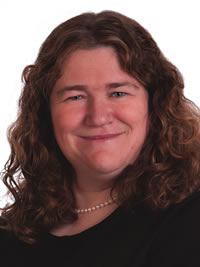 |
Picture: 2014 Overton
Prize Winner,
Dana Pe'er
|
2014 ISCB Overton Prize: Dana Pe'er
By Christiana N. Fogg1, Diane E. Kovats2*
1 Freelance Science Writer, Kensington, Maryland, United States of America,
2 Executive Director, International Society for Computational Biology, La Jolla, California, United States of America
* E-mail: This email address is being protected from spambots. You need JavaScript enabled to view it.
ISCB honors the achievements of an early- or mid-career scientist with the Overton Prize each year. The Overton Prize was established in memory of Dr. G. Christian Overton, a respected computational biologist and founding ISCB Board member who died unexpectedly in 2000. Winners of the Overton Prize are independent scientists in the early or middle phases of their careers that are recognized for their significant contributions to computational biology through research, teaching, and service.
ISCB is thrilled to recognize Dr. Dana Pe’er, Associate Professor in the Department of Biological Sciences and Systems Biology at Columbia University in New York, NY, as the 2014 winner of the Overton Prize. In recognition of this award, Dr. Pe’er will be a keynote speaker at this year’s Intelligent Systems for Molecular Biology conference in Boston, Massachusetts and will present a talk titled “A Multidimensional Single Cell Approach to Understand Cellular Behavior” on Monday, July 14, 2014.
Dana Pe’er: From Mathematics to Mass Cytometry
Dana Pe’er encountered her first love in second grade. Her father was eager to instill a passion for learning in her, and one day he showed her the proof demonstrating why the same number of natural numbers and rational numbers exist whereas the number of irrational numbers is greater than the number of rational numbers. Pe’er recalled, “Grappling with different strengths of infinity and the elegance mathematical logic made me fall in love with math.”
Pe’er received her bachelor’s degree in mathematics, and her master’s and Ph.D. degrees in computer science, all from the Hebrew University of Jerusalem. She did her Ph.D. research in the lab of Dr. Nir Friedman, where she had the realization that “statistical machine learning is a very powerful “math” to help elucidate biology, and the complexity of it all required computer science.” She recalls gaining several insights during this period that have accompanied her throughout her career, including her affirmation that, “Good modeling of the biology is the most important ingredient toward a good computational method for biological discovery. Rather than applying the most sophisticated “nuclear powered” method to squeeze the most out of the data statistically, one can use biological insight to limit the space of possible models more than any statistical method ever can.”
Making the right assumptions requires a good understanding of biology, knowledge Pe’er gained through her collaboration with Dr. Aviv Regev. They met as graduate students in Israel, where Regev greatly influenced how Pe’er thought of biological questions. Pe’er recalled, “She was my first real biology teacher and she taught me to think about biology more abstractly, rather than stick to more rigid and dogmatic thinking.”
Pe’er did her postdoctoral work with Dr. George Church at Harvard University, where she began navigating the messy world of experimental biology. Church’s mentorship gave Pe’er a new perspective of science, and she moved away from asking, “What type of computation can I do for this data?” and learned to ask instead, “What data do I need to answer a biological question I am passionate about?”
Pe’er describes the mentorship she received from Dr. Daphne Koller as being instrumental to her success as a trainee. Koller provided guidance and mentoring to Pe’er during her Ph.D. and postdoctoral training and instilled in her the importance of “good modeling assumptions.” Although Pe’er was not an official student of Koller’s, she recalls appreciatively the valuable career advice and insights Koller shared with her as she launched into her career as an independent researcher.
In 2006, Pe’er started her own lab at Columbia University in the Department of Biological Sciences and Systems Biology. Her lab embodies the interdisciplinary nature of her research and is filled with trainees from a wide range of backgrounds. She genuinely appreciates working with her trainees and has enjoyed “Watching them grow,and seeing how much they matured as scientists. I really love mentorship and feel a form of motherhood towards my trainees.”
Pe’er has developed several research projects that use large, complex data sets to examine how molecular networks respond to various external stimuli. One of her primary interests is using single cell technologies such as mass cytometry to better understand cellular heterogeneity. She is fascinated by this work and hopes “to reframe development not as a set of discrete cell types, but rather as a continuum, a dynamic process in which one can place each individual cell along a developmental trajectory that represents not only cell types, but their many cellular heterogeneity to cancer and the improvement of personalized cancer therapy.
Pe’er’s training in computer science and biology have given her a unique combination of skills and knowledge that have served her well as a computational biologist, but she sees her training experience becoming mandatory for future biology researchers. As she sees it, “Biology has become an information science. Enabled by an increasing number of technologies, the magnitude and complexity of the data is only increasing. In the future, computation will be an integral part of biology, like molecular biology is today.” Pe’er champions the power of doing science at the interface of biology and computation. “My “bilingual” training really lets me play at the interface,” she acknowledges. “It lets me communicate with both sides effectively and make connections. By understanding what powerful computation can do, I can design experiments and strive for technologies that might not be intuitive and obvious to a bench biologist that is less versed in computation. Designing the right data-rich experiment, matched with the right biology is truly empowering.”
Pe’er serves on the editorial board of the journal Cell, and she considers this role as a valuable opportunity to serve the scientific community. Cell has acknowledged computational biology as a critical rising field, and Pe’er sees her work on the advisory board as an important way to serve the computational biology community and help educate the journal about the field.
Outside of the lab, Pe’er has taken time to support and promote K12 science education by organizing a science expo. She was inspired to do this when she realized that her young daughter didn’t really know what she did. Pe’er recalled that her daughter “thought my job was ‘writing emails all day’. She did not realize that scientists are trying to figure out what we don’t know, rather than rehash what we do.” The expo was designed to transform a school into “a multi-story, hands-on, interactive science museum. Each volunteer scientist brings their lab and science to the kids, distilled in a way that is both engaging and clear to the kids.” She acknowledged that the expo presents a big but gratifying challenge to the volunteer scientists because they had to take “complex science and distill it in a way that can relate to a 5 year old. But, if you can explain your science to a 5 year old, you can explain it to anyone.”
Dr. Alfonso Valencia, chair of the ISCB Awards Committee, sees Pe’er’s selection as fitting recognition of her scientific contributions. He said, “I was very happy to see that Dana Pe'er was finally selected for the award. This is always a very difficult decision given the number of excellent young computational biologists in our community. Dana has published amazing papers with substantial impact in biology and cancer biology, together with other papers on method development that were very influential, some of them presented in ISMB.” Dr. Bonnie Berger, co-chair of the Awards Committee, also sees Pe’er as a rising luminary in the field of computational biology “for pioneering the use of Bayesian networks in cellular network inference.”
Pe’er is looking forward to where her research will take her, especially her ongoing work on single cell data. She is also enjoying and appreciating this moment of recognition. Pe’er was excited and uplifted when she was told she had been selected for the 2014 Overton Prize, and she recounted, “I got such an outpouring of congratulations from my colleagues, which was really the best."
>> Return to List of Overton Prize Recipients
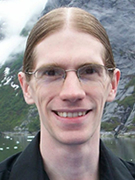 |
2015 Overton Prize Winner:
Curtis Huttenhower
|
2015 ISCB Overton Prize: Curtis Huttenhower
The Overton Prize recognizes early or mid-career scientists who are emerging leaders in computational biology and bioinformatics for their accomplishments in research, education, and service. The Overton Prize was instituted in 2001 to honor the untimely loss of G. Christian Overton, a leading bioinformatics researcherand founding member of the ISCB Board of Directors. Curtis Huttenhower is this year’s winner of the Overton Prize for his groundbreaking research on microbial communities, with a focus on the human microbiome.
Huttenhower is an Associate Professor of Computational Biology and Bioinformatics at the Harvard School of Public Health. He has worked on developing novel computational tools to analyze the large, complex datasets associated with microbial communities and NIH Human Microbiome Project. Huttenhower’s research has provided new insights into how microbial communities impact human health and disease. His research potential has been recognized through the receipt of the Presidential Early Career Award for Scientists and Engineers and an NSF CAREER Award.
>> Return to List of Overton Prize Recipients
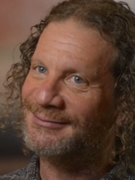 |
2015 Outstanding Contributions to ISCB Award: Larry Hunter
|
2015 ISCB Award: Larry Hunter
2015 marks the inaugural recognition of an ISCB member with the Outstanding Contributions to ISCB Award for his or her outstanding service contributions toward the betterment of ISCB through exemplary leadership, education, and service. Larry Hunter is the first winner of this award for his instrumental role in the foundation of ISCB as a scientific society.
Hunter is a Professor and Director of the Center for Computational Biology at the University of Colorado School of Medicine. His computational biology research interests include biomedical text mining and knowledge-based computational techniques for analysis of high-throughput data. Hunter began his career as a programmer at the U.S. National Library of Medicine (NLM), where he developed a database of researchers interested in artificial intelligence and molecular biology. He invited researchers from this database to a joint NLM-NSF meeting on artificial intelligence in molecular biology in 1992. This meeting developed into the Intelligent Systems in Molecular Biology Meeting (ISMB). By 1996, ISMB had emerged as the premier meeting for computational biology research, and members of previous ISMB steering committees concluded that this unique interdisciplinary field needed its own professional society. This group of committee members created the International Society of Computational Biology and elected Larry Hunter as its first president. Hunter has gone on to serve ISCB in many other capacities and continues to be closely involved with ISCB.
top
|
|
|
Picture: 2007 Overton Prize Winner,
Dr. Eran Segal
|
2007 Overton Prize Winner - Eran Segal
The International Society for Computational Biology is pleased to award the 2007 Overton Prize to Eran Segal of the Weizmann Institute of Science in Rehovot, Israel.
ISCB established the Overton Prize in 2001 in memory of G. Christian Overton, who was director of the Center for Bioinformatics at the University of Pennsylvania and a major contributor to the field. The award acknowledges community members who are less than 12 years post-degree and have already made major contributions to the field through research, education, service, or a combination of the three. “He [Overton] was a member of the ISCB Board of Directors, and his sudden death in 2000 was a shock to the community,” said Thomas Lengauer, chair of the ISCB Awards Committee. “Those of us who remember Chris Overton remember the kind of work he did—however laborious it was, it was always exciting and thought provoking, dominated by an innovative spark. Eran Segal seems to me to be especially deserving of this award in Chris's memory."
In the summer of 2006, Eran Segal and colleagues published a study in Nature (442, 772-778, 17 August 2006) hypothesizing that the instructions for wrapping DNA around nucleosomes are contained in the DNA itself, using a statistical computational model to predict exactly how that is done, and completing the proof by verifying the predictions with experiments in yeast.
"This important paper brought Segal and his main collaborator, experimentalist Jonathan Widom of Northwestern University, a lot of attention," says Lengauer. "It was featured in Nature's 'News and Views' section in an article by Tim Richmond, and the work was also described in a 'Making the Paper' section. And it made The New York Times on July 25, 2006.
Segal obtained his B.Sc. (summa cum laude) in computer science from Tel-Aviv University in 1998. He did his doctoral work in computer science and genetics at Stanford University, obtaining his Ph.D. in 2004. His advisor, Daphne Koller, remembers him vividly. "One of Eran's most impressive qualities," she says, "is his ability to get things done effectively and extremely well. He would be working on five projects, and I would be sure that at most one would get done. But not with Eran—he just kept producing idea after idea, result after result, paper after paper.”
Segal spent a year as a research fellow at the Center for Physics and Biology at Rockefeller University before joining the Weizmann Institute in 2005. "My lab develops quantitative statistical models aimed at understanding how molecular components interact in performing complex biological functions," Segal says. "We are interested in the control of transcription and translation and the structure of chromatin as it contributes to these. We are currently applying our ideas to the transcriptional network of the Drosophila embryo, in an attempt to develop thermodynamic models that will explain how cells compute the expression patterns of the system from the cis-regulatory DNA sequence and binding-site preferences of the participating transcription factors. We're also continuing our work on the DNA sequence preferences of nucleosomes and the way in which they specify the overall nucleosome organization."
Of his award, Segal says, "I'm very honored to be singled out, and I must thank my mentors, Daphne Koller and Nir Friedman, and my students, colleagues, and collaborators, people without whose efforts no progress could be made. In particular, I am enjoying close collaborations with several experimentalists like Jon Widom, Ulrike Gaul, and Howard Chang, and I'm extremely appreciative of their ability to confirm or refute in vivo the results that emerge from our lab's efforts in silico. We, in turn, take cues from their results in revising or adjusting our models. This prize affirms the value of our process."
Eran Segal will be presented with the 2007 ISCB Overton Prize in Vienna and give a keynote address on July 23, 2007. To read additional biographical information and view an abstract of his talk, Quantitative Models for Chromatin and Transcription Regulation," see
www.iscb.org/ismbeccb2007/ keynotespresentations/#segal.
Citation: Maisel M (2007) ISCB Honors Temple F. Smith and Eran Segal. PLoS Comput Biol 3(6): e128 doi:10.1371/journal.pcbi.0030128
>> Return to List of Overton Prize Recipients
2008 Overton Prize: Aviv Regev
|
|
|
Picture: 2008 Overton Prize Winner,
Aviv Regev
|
Brunak describes 2008 Overton Prize winner Aviv Regev as "a role model for how theoretical computer science can be applied to understanding biological organisms as systems." Trained initially at Tel Aviv University, she knew that her interests lay in bioinformatics “from day one.” She made her first contribution to the field developing mathematical models for the evolution of DNA methylation. It was at that early stage that she realized the value of synergy between computational and “wet lab” biology. “There was no data for one critical phylogenetic group that I was studying, so I went to work in the lab at The Hebrew University to fill in the gaps,” she said. “This experience gave me a good idea of how important it is to anchor theoretical biology in the real world.”
The idea that led directly to her graduate studies, however, came from a branch of computational science that at first glance has little, if any, connection with biology: pi calculus, typically applied to problems in electronic engineering. “I was listening to a conference talk by Robin Milner, on the application of pi calculus to dynamic communication networks, when it occurred to me that molecular networks can have similar properties,” she explains. Following this up, she developed a method for describing and understanding the dynamic relationships between entities in a biological system (such as proteins in an interaction network) using this type of “process algebra.”
After graduation, Regev took her first independent position at the Bauer Center for Genomics Research at Harvard University. There, her research interests switched to the use of probabilistic graphical models to reconstruct networks based on genomic and transcription data, using yeast as a model system.
In 2006, Regev took a position as an assistant professor at MIT and a Core Member of the Broad Institute. She has extended her network models to a range of applications including the characterisation of genes that are co-expressed in a range of cancer types but not in normal cells, and studying gene duplication. Once again, a chance meeting sparked a productive idea. “I was returning from a conference with Jill Mesirov, who had been trying to study variation in the gene expression of the malaria parasite in different patients’ blood cells,” she explains. “Mesirov’s data came from Johanna Daily and Dyann Wirth, infectious disease specialists from Harvard, who suspected that variation in gene expression might explain some of the observed variation in the clinical course of the disease. I wondered whether there might be equivalence to my own classification of yeast gene expression patterns, and so it proved: the malaria samples could be classified into three groups, similar to states characteristic of active growth, a starvation response, and a stress response in yeast.” This work was published in Nature in December 2007, and featured in the Making the Paper section.
This is not the first time that Regev’s work has been recognised by the ISCB. During the last decade, her name has appeared on four ISMB prize-winning posters or papers.
----
This article is excerpted from the July 2008 issue of PLoS Computational Biology. To link to the full journal article please visit www.ploscompbiol.org/article/info:doi/10.1371/journal.pcbi.1000101.
>> Return to List of Overton Prize Recipients

